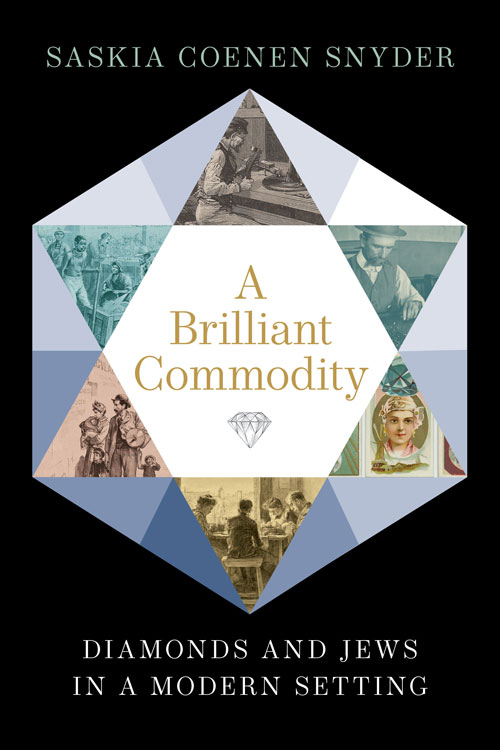
In A Brilliant Commodity (Oxford University Press), USC history and Jewish studies professor Saskia Coenen Snyder explores the diamond trade of the late 19th century and the critical role played by Jews at every level of an emerging international commodity market. With stops in the diamond fields of South Africa, the cutting factories of Holland and the trading hubs of London and New York, she carves a history as multifaceted and complex as the diamond itself.
There are lots of entry points to Jewish history in the latter part of the 19th century. You chose the diamond trade. Why that lens?
In part, it’s because of my background. I grew up in the Netherlands, and you cannot think about Dutch Jewish history without thinking about diamonds. And as a Dutch historian doing European Jewish history, it was almost a natural interest because diamonds are so crucial to the Amsterdam Jewish community. More than half the community depended on the stone at one time.
The second reason is that I like material culture history. My first book examined the material culture of synagogues — buildings as objects through which to understand historical change. Objects are storytellers. The diamond is also a very rich kind of storyteller, providing many facets of Jewish history.
The book is scholarly, but it’s also very readable. Did you set out to write a book with popular appeal?
It’s a story about the fingerprints and the faces behind the stone. It’s not necessarily about the stone itself. It’s about the hands that touch it, that work it, that take it across oceans. So, I wanted this book to reach a popular audience. And my editor really pushed me on this as well, to veer beyond the academic circles and make it a very readable story.

In A Brilliant Commodity, history professor Saskia Coenen Snyder explores the complicated role Jews played in the late 19th century international diamond trade.
Most of your subjects are anonymous — laborers in South Africa, cutters in Amsterdam, merchants in London. But there are also colorful characters like Barney Barnato, who grows up in London’s East End only to become this internationally known diamond magnate.
Barnato is born into a very poor family, but he was born at the right time, in a sense
— a time of imperial expansion, of the discovery of the diamond fields in the late
1860s in South Africa. He has family that have made the trek to South Africa, and
he hears stories about the money to be made. So, with a few dollars in
his pocket and a couple of boxes of cigars to sell, he crosses the Atlantic and walks
750 miles from Cape Town to the diamond fields. There was no real infrastructure,
so he’s walking alongside an ox cart. He basically makes a deal, as so many did: “Can
I travel with you? I’ll help you with whatever you need.” Then he sells his cigars,
makes a few pennies, and it grows from there.
Obviously, he was more successful than most folks who made that trek, but his early story, at least, is emblematic.
Most of the Jews in South Africa start as merchants, as peddlers that sell stuff that people need in the diamond fields. They sell shoelaces and spoons and buckets, all that stuff. But they soon find out that they can deal in diamonds primarily, even exclusively. So, Barnato builds himself up and becomes the most successful British Jewish entrepreneur. He really goes from rags to riches.
But his Jewishness always followed him. When you see sketches or cartoons in South African and British newspapers from the time, they always look like him — very wealthy Jews always seemed to look like Barney Barnato — so he became kind of a target. As successful as he was, as assimilated as he was in so many ways, he still wasn’t fully accepted. In a sense, he was never fully accepted by the Jewish public, either.
On that note, did you worry that people might jump to conclusions about the book itself based on existing stereotypes?
There has been a shift in Jewish studies over the past 15 years or so. In the past, scholars often shied away from some subjects. But as historians we can’t just ignore a chunk of history. Yes, some people were initially afraid that a book like this would strengthen certain stereotypes, particularly about alleged “Jewish power” or control in business, but that’s the knee-jerk reaction. Some succeeded, but many did not.
Within the diamond industry — I hope I made this clear in the book — Jews have a strong representation, but there were many who were not successful. They worked in factories, they made a living, but they didn’t become wealthy. Also, the diamond industry is not exclusively a Jewish business. There are many non-Jews in the industry as well, and the Jews that are involved play a host of roles, from the 14-hour-a-day laborer cutting stones to Henri Polak, who played a critical role in the Dutch labor movement.
The book is also about a specific commodity market — there’s a lot to unpack. Did you ever worry you’d lose sight of your thesis?
Yeah, it was difficult because I got pulled in all these different directions. For instance, the chapter in Holland is very much on labor history. The one in the United States is more about immigration policies, but also on how Jews and diamonds feature in literature and advertising at that time. And the one in London draws us to how diamonds were presented in exhibitions and world fairs.
The constant challenge was to bring this all back into one cohesive narrative. I had to make decisions about things that deserved more attention — for instance, the role of women in the diamond trade. But you can't do it all. It would have been a 1,000-page book and would have taken another 10 years to write!